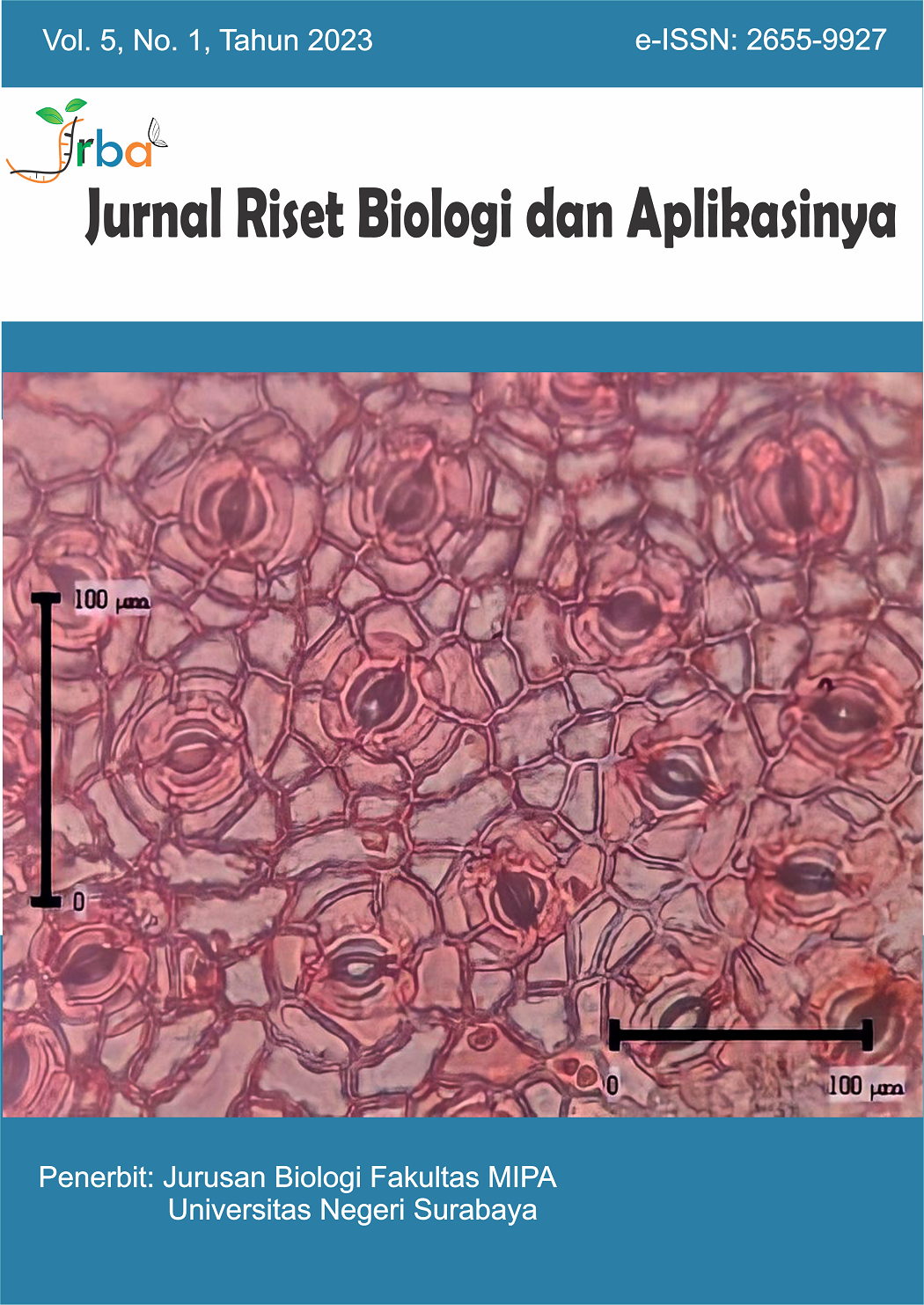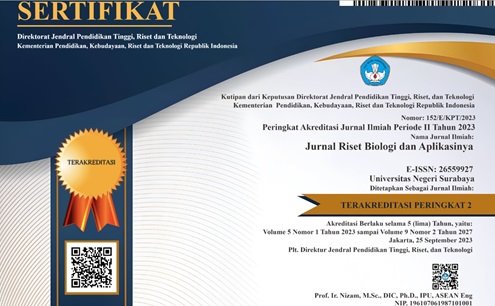Effects of Zinc Accumulation on Earthworm Aporrectodea caliginosa (Haplotaxida: Lumbricidae)
DOI:
https://doi.org/10.26740/jrba.v5n1.p8-15Abstract
Earthworms are key to the earth's ecosystem, which helps the soil increase its fertility and repair its existing elements, as well as remove contaminants. This study investigated the accumulation of Zn in the earthworm Aporrectodea caliginosa after 15 days of exposure. The worms were grown in media with different concentrations of Zn between 750 and 1500 ppm. Each treatment consisted of three replicates, containing 30 worms. A control group without Zn was also used. Data were analyzed by using Duncan Multi–Range. The results revealed that A. caliginosa had a strong ability to accumulate Zn in its tissue compared to the control group. It was noticed that the increase of the heavy metal in the worm´s tissue is associated with the elevation of the metal in its media. The results show a significant loss of weight in the worm´s body and loss in the growth rate; they also shown a decrease in specific growth rate. Moreover, there was a significant decrease in the worm length, showing a high effect, especially after 15 days of breeding with all concentrations used in this study. The researchers recommend using earthworms to purify the soil from contaminants because earthworm has a great ability to get rid of all pollutants, whether metals or pesticides or parasites, especially in industrialized countries and agricultural lands.
References
Al-Rawi, K.M & Khalafullah, A.(1980). Design and analysis of agricultural experiments. Mosul: Dar Al Kutb .
Al-Safawi, A.Y.T. (2006). Environmental pollution of Mosul city and treatment methods. PhD dissertation, University of Mosul. Mosul, Iraq.
Akber, M. M., AL-Saad, H. T., and Ghadban, A.M. (2011). Bioaccumulation and effect of some heavy metals on worm Namalycastis indica (Annelida: Polychaeta). Journal of Research Basra (Science), 37 (15B), 46-51.
A.P.H.A. 1985. Standard methods of the examination of waste and wastewater. 16thedu. American Public Health Association. Washington, D. C.
Dai, J., Becquer, T., Rouiller, J.H., Reversat, G., Bernhard-Reversat, F., Nahmani, J. & Lavelle, P. (2004). Heavy metal accumulation by two earthworm species and its relationship to total and DTPA-extractable metals in soils. Soil Biology & Biochemistry, 36, 91-98. https://doi.org/10.1016/j.soilbio.2003.09.001.
Hasan, M.S. (2011). Effect study on nutrition media and different temperature on earthworm growth Lumbricus terrestris. (Oligochaeta: Annelida). Journal of Babylon University/Pure and Applied Sciences, 19 (2), 617- 622.
Homa, J., Niklinska, M. & Plytyez, B. (2003). Effect of heavy metals on coelomocytes of the earthworm Allobophpora chlorotica. Pedobiologia, 47(5-6): 640-645. https://doi.org/10.1078/0031-4056-00239.
Iordache, M. & Borza, I. (2012). The bioremediation potential of earthworms (Oligochaeta: Lumbicidae) in a soil polluted with heavy metals. Journal of food Agriculture & Environment, 10(2),1183-1186.
Latha,V. & Mahaboob-Basha, P. (2016). Extent of heavy metal accumulation in sewage irrigated soils and their impact on distribution of earthworm communities: linking Chromium and Zinc toxicity on growth and reproduction in selected earthworm species. Current World Environment ,11(1), 279-29. http://dx.doi.org/10.12944/CWE.11.1.34.
Liesch, A.M., Weyers, S.L., Gaskin, J.W., and Das, K.C. (2010). Impact of two different biochars on earthworm growth and survival. Annals of Environmental Science, l 4: 1-9. https://openjournals.neu.edu/aes/journal/article/view/v4art1.
Loureiro, S., Soares, A.M.V.M., & Nogueira, A.J.A. (2005). Terrestrial avoidance behavior tests as screening tool to assess soil contamination. Environ Pollution, 138, 121-131. https://doi.org/10.1016/j.envpol.2005.02.013.
Morgan, J.E., & Morgan, A.J. (1993). Seasonal changes in the tissue-metal (Cd, Zn, and Pb) concentration in two eco physiologically dissimilar earthworm species: Pollution- monitoring implications. Environ Pollution, 82 (1), 1-7. https://doi.org/10.1016/j.scitotenv.2013.08.090.
Nahmani, J. & Lavelle, P. (2002). Effects of heavy metal pollution on soil macrofauna in a grassland of northern France. Euro Journal Soil Biology, 38,297-300. https://doi.org/10.1016/S1164-5563(02)01169-X.
Odoh, R., Agbaji, E.B., Kagbu, J.A., & Thomas, S.A. (2011). Heavy metal speciation in agricultural farmland in some selected local government areas of Benue state, Nigeria. Archives. Appl. Sci. Research, 3, 560-573.
Ogbonna, C.B., & Berebon, D.P. (2013). Observations on the ecology of earthworms and effect on the population dynamics of cellulolytic bacteria in soils across selected habitats in imo state University Main Campus Owerri, Nigeria. Journal of Environmental Science, Toxicology & Food Technology, 5(4), 17-22.
Sogbesan, A.O., & Ugwumba, A.A.A. (2006). Effect of different substrates on growth and productivity of Nigeria semiaridzone earthworm (Hyperiodrilus euryaulos Clausen1842) (Oligochaeta: Eudrinae). World Journal of Zoology,1(2),103-112.
Song, Y., Zhou, Q., Gong, P., & Sun, T. (2005). Eco toxicity of soil contaminated with industrial and domestic wastewater in western Shenyang, China. Sci. Chem. Sci. C. Life. Sciences, 48(1), 48-56. https://doi.org/10.1007/BF02889801.
Tischer, S. (2009). Earthworms (Lumbricidae) as biondicators: The relationship between in soil and in tissue heavy metal content. Journal Polish of Ecology, 57(3), 513-523.
Usmani, Z., & Kumar, V. (2015). Review paper open access role of earthworms against metal contamination: a review. Journal of Biodiversity and Environmental Sciences, 6(1), 414-427. https://innspub.net/role-of-earthworms-against-metal-contamination-a-review/.
Uzoma, K.O., Iroha, A .E., Chinyere, C.G., Sunday, E.A., Kelechukwu, D.M., & Ahuwaraeze, N.L. (2013). Effects of mining effluent contaminated soil treated with fertilizers on growth parameters, chlorophyll and proximate composition of Cucurbita pepo vegetable. J. Biodiver. Environ. Sci, 3,1-8.
Zaltauskaite,J., & Sodiene, I. (2010). Effects of total cadmium and lead centrations in soil on the growth, reproductionand survival of earthworm Eisenia fetida. Ekologija. 56(1-2): 10-16.
Downloads
Published
How to Cite
Issue
Section
License
Copyright (c) 2023 Jurnal Riset Biologi dan Aplikasinya

This work is licensed under a Creative Commons Attribution-NonCommercial 4.0 International License.
 Abstract views: 342
,
Abstract views: 342
, PDF Downloads: 120
PDF Downloads: 120












